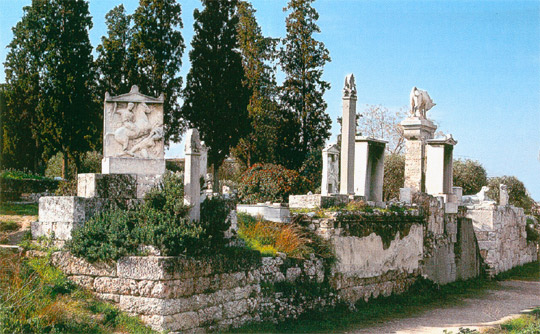Funerary Realm
Greeks and Romans imagined a universe in which connections between the living and the dead remained strong. Through correct burial rites and prominent memorials, survivors showed due respect to the dead in hopes of ensuring them a positive afterlife. Neglect of these tasks was considered an insult not only to family honor, but to human dignity and to the gods.
Burial rites, usually carried out by the deceased’s female relatives, consisted of three parts: the laying out of the body, the funerary procession, and the ceremony of interment. Throughout the preparations, friends and relations joined in songs and acts of lamentation, a common subject appearing on Greek vases as early as the ninth and eighth centuries BCE. Long after the funeral, family members continued to pay regular visits to the grave with votive offerings and libations. This practice by classical Greek women is depicted on many white ground lekythoi (oil vessels for anointing the body of the dead), including the two featured in this exhibit.
 Both inhumation and cremation burials were practiced. In cases of the latter, ashes were placed in cinerary urns, which were then either buried in the ground or deposited in tombs; in the former, sarcophagi, usually made of marble, but occasionally stone, lead, or wood, served as coffins. In periods when inhumation was more popular, elaborately sculpted sarcophagi depicting scenes from myths became popular memorials.
Both inhumation and cremation burials were practiced. In cases of the latter, ashes were placed in cinerary urns, which were then either buried in the ground or deposited in tombs; in the former, sarcophagi, usually made of marble, but occasionally stone, lead, or wood, served as coffins. In periods when inhumation was more popular, elaborately sculpted sarcophagi depicting scenes from myths became popular memorials.
To commemorate the graves of wealthy and aristocratic citizens, families often erected stelai (tombstones) and other monuments of marble. Typically, such monuments included a lifelike image in relief of the deceased, sometimes shown with family members, possessions, or a favorite pet. Inscriptions might provide additional details about the deceased’s life, occupation, age, attributes, or relationships. Tomb reliefs from Palmyra in Syria depict men and women adorned in rich fabrics and jewels, enjoying a banquet. Like most marble sculpture of the ancient world, these funerary monuments would have been brightly painted.
Image credit: Gravestones at Kerameikos Cemetary, Athens, Greece. Photograph courtesy of Wikimedia Commons.

 Earlier
Earlier Earlier
Earlier







